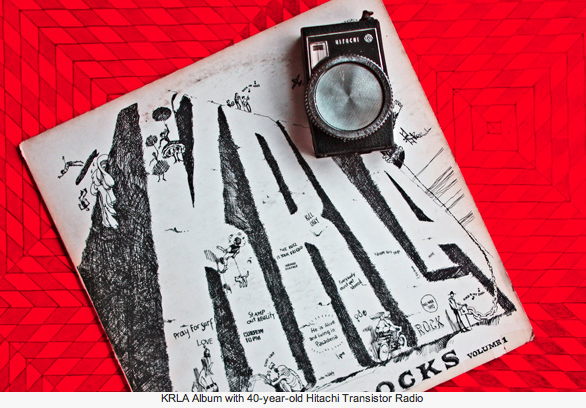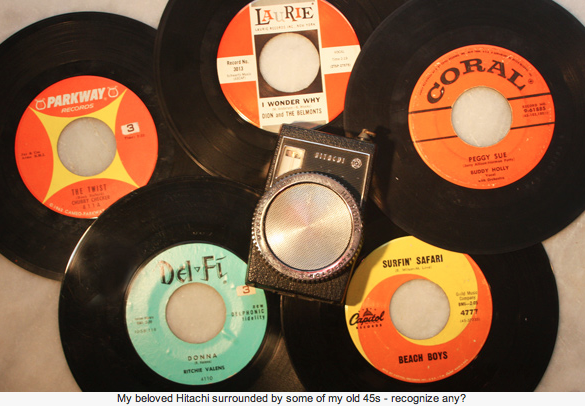AKA Bruce’s Guide to the Evolution of Technology and His Kandy-Kolored Tangerine-Flake Streamline Baby, Part One*
I so vividly remember my first portable radio. It had such an exotic name for the day – a transistor radio! For many of us, this changed our lives. Portable music. What a radical concept!
This will be the first in a series of reflections on the evolution of technology from this baby-boomers memory, which I will readily admit has many holes in it. But, there have been those moments that stick with me, as with others, whether it be where I was when I learned of JFK’s assassination and the days that followed, or seeing The Beatles on The Ed Sullivan Show for the first time, or in technology terms seeing that NBC peacock for the first time in color and thinking it looked sort of lame after all the hype of color television. This series, however, will focus on technological memories.
The first BIG technology toy I got was my transistor radio. I really thought it was as space age as they came. I wonder if any kid today even knows what a “transistor” is? Heck, I still don’t even know what a transistor is? I knew there were tubes in our old radio and TV, but transistors? All I knew is it took it didn’t take time to warm up, like our big old radio in our house. But, what made my Hitachi transistor radio so cool, and it was really cool, was that the speaker in front, was the dial!
AND, it was portable! Portable – I could take it with me! I could listen under the covers in my bed, in my room! I carried that transistor radio around like it was the Holy Grail. It truly was a marvel to me. I’m not sure, but I think it only received AM radio. FM was not on our radar at all, when I was growing up. That came later, in college.
Our kids don’t remember how we had to listen to music. In the living room, either on the big family radio or on the family record player, which doubled as a substantial and heavy piece of furniture. They weren’t called stereos until sometime during the mid-sixties after, I believe, The Beatles released “Sgt Pepper’s Lonely Hearts Club Band.” Even then, Stereos didn’t become common-place for several years thereafter. So, us kids were stuck listening to our parent’s music (Patti Page, Lawrence Welk, Big Bands, Roy Rogers, and maybe if we were lucky and our parents had some taste: Sinatra, Dean Martin, or some Jazz).
We’d get to sometimes listen to our 45′s or LP’s and, of course, watch our favorite rock ‘n’ roll acts on The Dick Clark Show and The Ed Sullivan Show on the one Black and White television set in the house, in the living room. For The Ed Sullivan Show, it meant enduring opera, jugglers, other circus acts, Topo Gigio, etc. before The Animals, The Mamas and the Papas, The Doors, Paul Revere and the Raiders, and the like finally came on to lip-sync their one or two numbers.
But, the portable radio, the transistor radio changed all that. We were freed. We were released. We were on our own. It was unbelievable. It was liberating and magical. AM Radio and 45 RPM Singles were “it” for me and my friends. There was a local record store we’d hang out at called “The Frigate.” Everyone had their local record store, I’m sure, whether they lived in a big city like Los Angeles as I did or smaller towns all over the United States and elsewhere. In my youth, my circle of existence pretty much was as far as my legs could pedal my Schwinn bicycle, so for all practicality it was a small town to me. I would pick up the Top 30 list from KHJ each week, the competitor to KRLA, and feverishly study the new hits on that list.
But, that Hitachi. It was glued to my ear, my side, my pocket much the way our kids have their tech toys attached to themselves today. Only, with me, it was this one battery operated transistor radio. It was just as important to me as any smart-phone, iPod, GameBoy, or other portable device the kids take with them these days. No, it was more important because it was first and it changed our lives. I cherished it.
Do you remember your first transistor radio? I can picture it today, though I can’t remember the name of a single teacher, picture the face of a single teacher from elementary through high school (for real), but I can totally remember almost every detail of that Hitachi radio. I’m not sure what that says about me?
By the way, do you remember where you were when JFK was assassinated? Or where you were when Neil Armstrong walked on the moon on July 21, 1969 and said, “That’s one small step for man, one giant leap for mankind.”
Other technology to be covered in this series will be the 8-track, car-stereos, those amazing stack record players that dropped the LPs, reel-to-reel tape recorders, 8mm movie cameras, movies, and home editing machines, home dark-rooms, junior high science fairs, the first Sony Walkman, record stores with listening booths (in Hollywood), as well as your suggestions.
Postscript: As it turns out, after I wrote this article, I was able to find both that original Hitachi transistor radio in my memorabilia boxes and also a cool record LP from the same time, released by one of our local radio stations in Los Angeles, KRLA, both pictured above. It was a Transistor 6 Hiphonic – Model TH -600. Used s 9-Volt Battery. Yeah, you guessed it. I couldn’t resist. Got one. IT STILL WORKED! The first station I found was an Oldies Station and the song playing was “After the Loving” by Engelbert Humperdinck!
Does Hitachi exist anymore? Anyone know? Those 21 “Solid Rocks” on that KRLA album included, “Dirty Water” by The Standells, “Psychotic Reaction” by the Count 5, “Farmer John,” by the Premiers, “Little Latin Lupelu,” by the Righteous Brothers, “You Turn Me On,” by Ian Whitcomb, “The Duck” by Jackie Lee, and “Keep On Runnin’” by the Spencer Davis Group. How many of those songs do you remember?
*an homage to Tom Wolfe’s first collected book of essays, published in 1965
NOTE: I co-founded the website BoomerTechTalk.com and this was originally published there. It was the first of five Evolution of Technology columns, several co-written with Professor David E. Weber. I will be published those original five columns here and then, hopefully, continuing the series with completely new originals.



